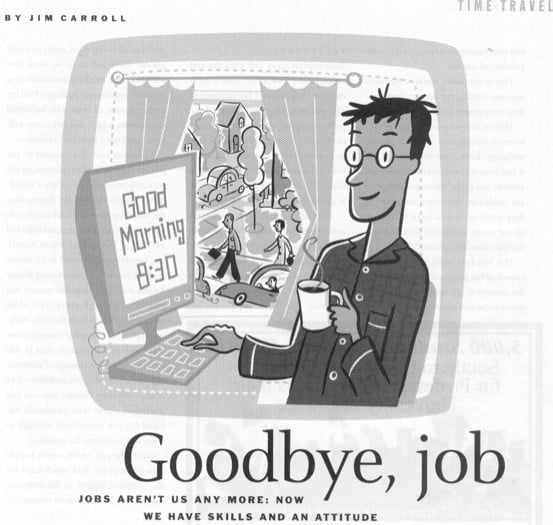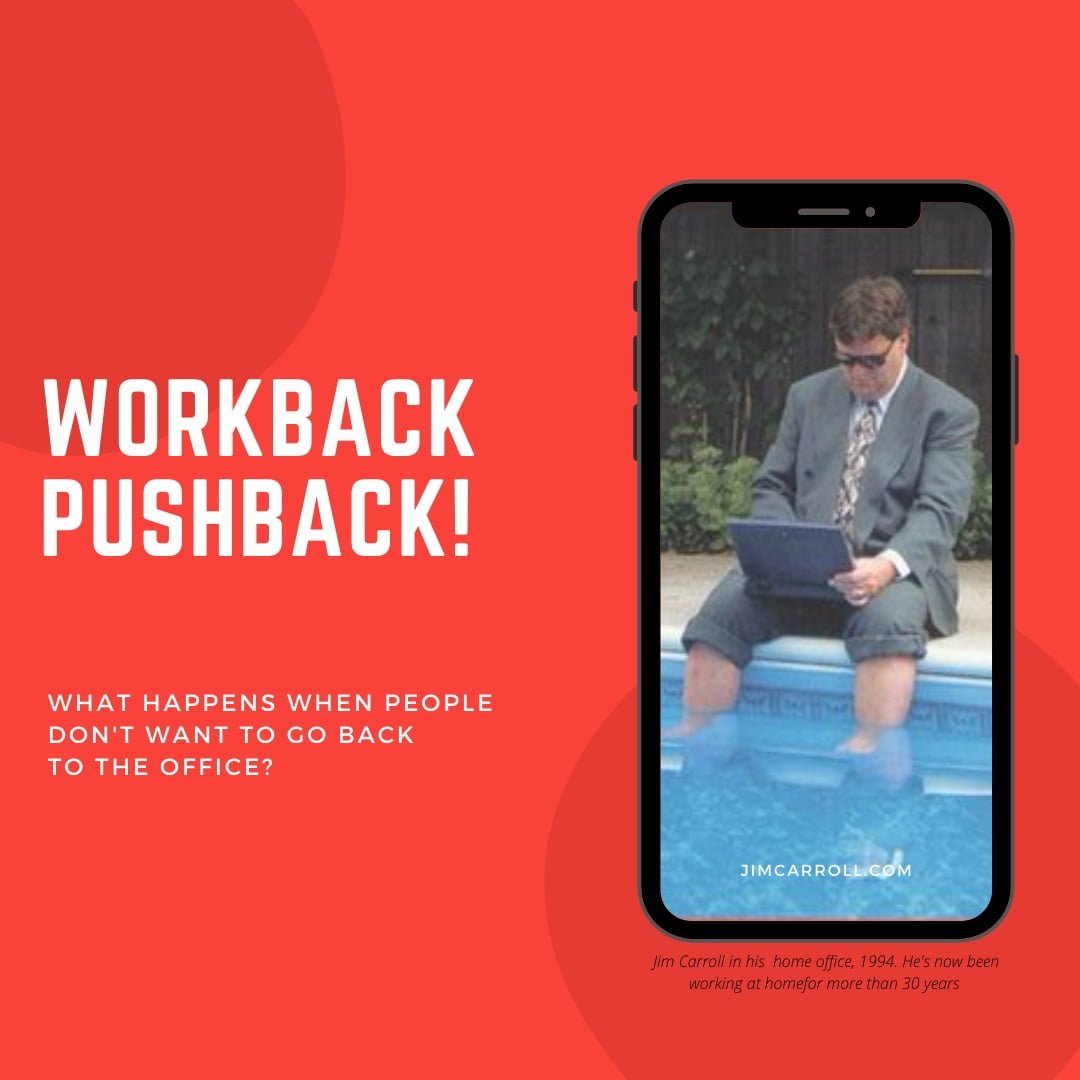Back at the end of the 90s, while the dot.com world was flying high, I was already busy speaking and writing about the future – with constant media interviews. In addition, I wrote for numerous Canadian publications – the Globe & Mail, National Post, Profit, Marketing Magazine. Not only that, but I was busy with radio shows – I had an in-air show the global airline Air Canada (“dot. commerce with Jim Carroll“) and a monthly magazine column with the now-defunct Canadian Airlines (subsumed into Air Canada), called Time Travel.

The latter was a fun column to write – I took on a subject, looked back in time, examined the present day, and cast my mind forward into the future. Looking back, most of the parts about looking forward were bang on as to where we are today, 20 years on.
While searching for something on my main home desktop, I stumbled across this particular article – and examining it again, I was predicting the basis for today’s “Great Resignation”. I did that a lot of that back then – read this post where I filmed a show about the issue, and how it’s not really new – but is defined by the lifestyle choices that people choose to pursue over traditional career options.
Now, as companies start to call employees back to work – will they go in? I suspect it won’t unfold as companies have hoped – an issue I covered in another show I recently did in which I talk about what I call Workback Pushback!
Have a read on what I wrote in 2000 which was already covering the essence of this trend.
Goodbye, Job
Jobs Aren’t Us Any More: Now We Have Skills and An Attitude
Canadian Airlines Magazine, April 2000
By Jim Carroll (PDF Version – GoodbyeJob)
Talk to some people today, and you’ll encounter individuals who are proud to say that they don’t have a job, a steady income, or any real idea of how they might earn a living a year from now. Ask them what they wear to work, and they might indicate pajamas. Ask them their overriding career goal, and they might indicate lifestyle. Ask them what they do, and they’ll tell you that economists have given them a number of different names. They’re temporary workers. Nomadic workers. Contingent workers. Independent contractors. Contract workers. Outsourced employees.
They’re the vanguard of the new economy, a world in which people no longer have a job for life. In fact, as we enter the 21st century, it’s become fashionable not to have a job, but rather, to have an attitude: “we’ve got skills that are needed by the corporate sector. If they want us, they’ll have to hire us on our terms, even if that means that we’ll work for them on a part-time basis.”
The last few years have seen the launch of the temporary economy, and the concept of the job and career promises never to be the same as a result.
Yesterday
Most experts agree that up until the mid-1800s, most people didn’t have a “job” – instead, they worked for themselves. The economy, largely agricultural and entrepreneurial, saw many individuals eking out a living on the family farm or in a small-scale business that served the local community, not unsurprising that most people worked within a few minutes walk of where they lived. After all, in the era of the horse and buggy, it was difficult to travel any further!
Yet all of this changed as the industrial revolution took hold. The most dramatic development occurred with Henry Ford and the invention of the automobile and the concept of the modern-day assembly line. Suddenly the workforce had mobility, allowing people to easily travel somewhere in order to go to work.
Not only that, but the modern manufacturing methods popularized by Ford led to the large-scale industrial enterprise, an organization that needed a lot of full-time employees in order to function.
Thus was born the concept of the job. By the 1950s, the transition in the economy was complete, with those who worked for themselves being the minority in an economy in which most people in the workforce held full-time jobs. The typical North American family was captured by the romantic notion of the Nelson family in the TV show Ozzie & Harriett. Here’s what the world was all about, a place where Dad wore a suit and went to work every day, while Mom stayed home with the kids, Ricky and David. Hollywood also typified the nature of the workplace in the popular movie, The Man in the Gray Flannel Suit, in which Gregory Peck played an office worker who caught the 8:05am train to work every day.
Unswervingly loyal to the company, he worked in a world in which no one was ever fired, and everyone had a job for life.
Implicit throughout this period was the emergence of a deal that was struck between the organization and the individual – give us your loyalty and work hard for us, indicated the company, and we’ll give you a job for life. People worked hard and came to believe in the company they worked for.
Today
Attitudes like that died, fast and furious with the recession of the 1990s.
It was a period that some have come to call the “white-collar recession.” For the first time, professional workers within offices found their jobs and careers at risk, as a particularly nasty wave of economic restructuring took place. The period of downsizing also led to a very significant change in the attitude that many people had towards the corporation.
Why? Because many individuals came to believe that the corporate world had come to break the social contract that had long existed in the previous 100 years. After all, people came to realize that the company they worked for might choose to let them go at any time, without warning. How could they possibly be loyal to the company, when the company no longer guaranteed them a job for life?
Such changing attitudes led to a rather unique situation, in which many of those who found themselves in a difficult situation decided not to seek another job in the corporate sector. Instead, economists began to notice that vast numbers of them were deciding to take care of themselves by establishing their own small company, often working out of their homes. Rather than seeking a job, they were setting themselves up to provide their skills and talents to the corporate sector on a part-time basis.
Of course, this line of thinking fit the mindset of the corporate world of the time. Many large organizations came to be reluctant to hire full-time staff, given the fact that severance packages had become rather extreme. They were all too eager to hire the contingent workforce that was appearing before their very eyes.
Tomorrow
There are those who believe that technology will help to enshrine the concept of the nomadic workforce, and as with everything, the Internet will play a key role.
Why? The reason is simple: the Internet is the foundation for an economy in which a growing number of nomadic workers are able to easily serve an ever-increasing number of clients located far beyond their local geographic area. The era of inexpensive global telecommunications is upon us, one in which e-mail, telephones, cell phones, faxes, and video conferencing allow people to work from anywhere, at any time. This means that many more people will choose to go the independent route, and because of the lifestyle implications, will choose to work from a home office.
Does this mean that we are doomed to a world in which once again, people are but a few minutes away from their place of work?
Not at all – indeed, those who work at home have come to realize that social interaction remains a key element of the working world. So even while they’ll work at home, they’ll also come to quickly and frequently jump on the automobile of the 21st century – the jet airplane. With a client base that is global in nature, the nomadic worker will come to find that even though they don’t have a job, their job will continue to take them to far away and distant places.





GET IN TOUCH
Jim's Facebook page
You'll find Jim's latest videos on Youtube
Mastodon. What's on Jim's mind? Check his feed!
LinkedIn - reach out to Jim for a professional connection!
Flickr! Get inspired! A massive archive of all of Jim's daily inspirational quotes!
Instagram - the home for Jim's motivational mind!